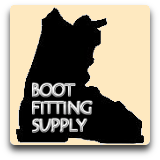Ski Boot Help
Home > Ski Boot HelpContinue Shopping
5 Basic Tips to help you with your ski boots.
1. Protect boot toes and heels.
Don’t kick your ski boot heels on the ground to set the heel in your boots. Instead, as you buckle your boots and with the boot sole flat on the ground, flex forward in each boot pushing your shin against the boot tongue to set your heel tight in the heel area of your ski boots. Also, carry your boots using a ski boot carrier, boot bag or gear bag. When walking in you ski boots, avoid concrete and don’t drag your boots on the ground. Worn out or damaged toes and heels on ski boots can affect binding release reliability, and some shops won’t mount bindings on your skies due to boot wear.
2. Pull your boot liners on occasion.
Removing your boot liners on occasion will allow the liner to completely dry and rebound its shape. It’s recommended to use our ski boot horn to replace the liners. It makes it much easier, protects your hands and the liners.
For more information about the Ski Boot Horn visit the pages below:
Note - Issues with boot dryers and sprays: Eventually dryers may un-mold heat moldable liners. Dryers also need energy or an outlet. Another disadvantage is a room with boot dryers can be a bit aromatic. Sprays are just messy and they leave a slippery residue on the inside of your boots which is not good when skiing.
3. Keep your boots buckled.
When kept buckled, the shell retains its shape and makes buckling them much easier. When boots are buckled, buckles won’t get caught on things or damaged in transit. Buckled boots will be happy and well behaved.
4. Lube your boot buckles.
Use a light oil like mineral oil or a bike lube like T9 once a year on all buckle threads and metal on metal contact points to keep the buckles working smooth and to prevent seizing. If a buckle stops turning, first try some WD40 on the threads then work it back and forth to loosen. Once buckle moves again, lube buckle as described above. If the buckle won’t move, it may have been stuck for too long or otherwise damaged and may need to be replaced.
5. Keep your boots warm.
Warm boots are much easier to get on and your feet. Cold boots will make your feet freeze instantly. Let them live in the house, not in the garage or shed. Warm boots perform better and will be happy and well behaved.
Ski Boot Help - 5 Tips To Help with Ski Boots.
Putting Ski Boots on easier using our Ski Boot Horn!
Contact us with questions about enhancing your boot fit. Check out our boot fitting supplies.
![]()
![]()
